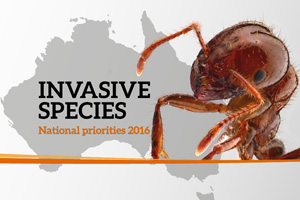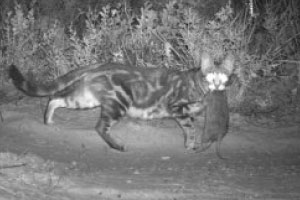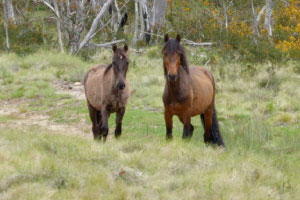
Restocking Kosciuszko: Regression of a national heritage icon
Kosciuszko National Park is being restocked by a farm animal – the horse – and it is happening by default. There is no plan and no sense of urgency to stem this restocking.

Kosciuszko National Park is being restocked by a farm animal – the horse – and it is happening by default. There is no plan and no sense of urgency to stem this restocking.

Feral deer are out of control in NSW, and have been declared the state’s ‘most important emerging pest animal threat’.

We have identified seven key areas for reform as part of our 2016 national priorities.

Leading conservation organisations are urging the NSW Government to fully implement the recommendations of the NSW Natural Resources Commission’s pest animal management review.

We’ve argued for a greater focus on the eradication of new and emerging invasive species in the current NSW pest animal management review.

The critically endangered Norfolk Island parrot – known to locals as the Green Parrot – has the dubious honour of having to be rescued from the brink of extinction not once, but twice.

Treating feral deer as game rather than pests. The potential for goat farming to create major landscape degradation. Zero policy on how to tackle red-eared slider turtles. These are just some of the issues we raised recently at a workshop put on by NSW’s Natural Resources Commission.

Moves by federal and state governments to change the way Australia manages high impact pests and diseases has set our alarm bells ringing. Are our governments looking at hoisting the white flag on all but a few popular causes?

When federal environment minister Greg Hunt made feral cats public enemy number one at the recent Threatened Species Summit his call to cull two million cats elicited an unexpected response from one quarter.

The Tasmanian Government must act now to stop feral deer numbers exploding or else the agricultural and environmental damage they cause will quickly become overwhelming.

Environmental damage is increasing from Victoria’s rapidly expanding feral deer population.

Three months out from a state election NSW environment minister Rob Stokes has ruled out using the only option left to prevent growing feral horse numbers in Kosciuszko National Park – aerial shooting.

Solving the problem of feral cats in the Australian environment will require long-term, well-resourced steps. But with the right will, it can be done.

As feral horse numbers grow in the Australian Alps in the absence of an effective control program, so too is concern about the escalating damage.

The Action Plan for Australian Mammals 2012 has revealed that feral cats, followed by inappropriate fire regimes and the red fox are the greatest threats to Australia’s threatened mammals.

Kosciuszko National Park is being restocked by a farm animal – the horse – and it is happening by default. There is no plan and no sense of urgency to stem this restocking.

Feral deer are out of control in NSW, and have been declared the state’s ‘most important emerging pest animal threat’.

We have identified seven key areas for reform as part of our 2016 national priorities.

Leading conservation organisations are urging the NSW Government to fully implement the recommendations of the NSW Natural Resources Commission’s pest animal management review.

We’ve argued for a greater focus on the eradication of new and emerging invasive species in the current NSW pest animal management review.

The critically endangered Norfolk Island parrot – known to locals as the Green Parrot – has the dubious honour of having to be rescued from the brink of extinction not once, but twice.

Treating feral deer as game rather than pests. The potential for goat farming to create major landscape degradation. Zero policy on how to tackle red-eared slider turtles. These are just some of the issues we raised recently at a workshop put on by NSW’s Natural Resources Commission.

Moves by federal and state governments to change the way Australia manages high impact pests and diseases has set our alarm bells ringing. Are our governments looking at hoisting the white flag on all but a few popular causes?

When federal environment minister Greg Hunt made feral cats public enemy number one at the recent Threatened Species Summit his call to cull two million cats elicited an unexpected response from one quarter.

The Tasmanian Government must act now to stop feral deer numbers exploding or else the agricultural and environmental damage they cause will quickly become overwhelming.

Environmental damage is increasing from Victoria’s rapidly expanding feral deer population.

Three months out from a state election NSW environment minister Rob Stokes has ruled out using the only option left to prevent growing feral horse numbers in Kosciuszko National Park – aerial shooting.

Solving the problem of feral cats in the Australian environment will require long-term, well-resourced steps. But with the right will, it can be done.

As feral horse numbers grow in the Australian Alps in the absence of an effective control program, so too is concern about the escalating damage.

The Action Plan for Australian Mammals 2012 has revealed that feral cats, followed by inappropriate fire regimes and the red fox are the greatest threats to Australia’s threatened mammals.

Kosciuszko National Park is being restocked by a farm animal – the horse – and it is happening by default. There is no plan and no sense of urgency to stem this restocking.

Feral deer are out of control in NSW, and have been declared the state’s ‘most important emerging pest animal threat’.

We have identified seven key areas for reform as part of our 2016 national priorities.

Leading conservation organisations are urging the NSW Government to fully implement the recommendations of the NSW Natural Resources Commission’s pest animal management review.

We’ve argued for a greater focus on the eradication of new and emerging invasive species in the current NSW pest animal management review.

The critically endangered Norfolk Island parrot – known to locals as the Green Parrot – has the dubious honour of having to be rescued from the brink of extinction not once, but twice.

Treating feral deer as game rather than pests. The potential for goat farming to create major landscape degradation. Zero policy on how to tackle red-eared slider turtles. These are just some of the issues we raised recently at a workshop put on by NSW’s Natural Resources Commission.

Moves by federal and state governments to change the way Australia manages high impact pests and diseases has set our alarm bells ringing. Are our governments looking at hoisting the white flag on all but a few popular causes?

When federal environment minister Greg Hunt made feral cats public enemy number one at the recent Threatened Species Summit his call to cull two million cats elicited an unexpected response from one quarter.

The Tasmanian Government must act now to stop feral deer numbers exploding or else the agricultural and environmental damage they cause will quickly become overwhelming.

Environmental damage is increasing from Victoria’s rapidly expanding feral deer population.

Three months out from a state election NSW environment minister Rob Stokes has ruled out using the only option left to prevent growing feral horse numbers in Kosciuszko National Park – aerial shooting.

Solving the problem of feral cats in the Australian environment will require long-term, well-resourced steps. But with the right will, it can be done.

As feral horse numbers grow in the Australian Alps in the absence of an effective control program, so too is concern about the escalating damage.

The Action Plan for Australian Mammals 2012 has revealed that feral cats, followed by inappropriate fire regimes and the red fox are the greatest threats to Australia’s threatened mammals.
Get our blog the Feral Herald delivered to your inbox.
Our protected areas are being trashed, trampled, choked and polluted by an onslaught of invaders. Invasive species are already the overwhelming driver of our animal extinction rate, and are expected to cause 75 of the next 100 extinctions.
But you can help to turn this around and create a wildlife revival in Australia.
From numbats to night parrots, a tax-deductible donation today can help defend our wildlife against the threat of invasive weeds, predators, and diseases.
As the only national advocacy environment group dedicated to stopping this mega threat, your gift will make a big difference.
A silent crisis is unfolding across Australia. Every year, billions of native animals are hunted and killed by cats and foxes. Fire ants continue to spread and threaten human health. And the deadly strain of bird flu looms on the horizon. Your donation today will be used to put the invasive species threat in the media, make invasive species a government priority, ensure governments take rapid action to protect nature and our remarkable native wildlife from invasives-led extinction, death and destruction.
If you are having trouble submitting a form, please read this guide.
Please fill out the following form and one of our team will be in contact to assist as soon as possible. Please make sure to include any helpful information, such as the device you were using (computer, tablet or mobile phone) and if known, your browser (Mozilla Firefox, Chrome, Safari etc)
"*" indicates required fields
Dear Project Team,
[YOUR PERSONALISED MESSAGE WILL APPEAR HERE.]
I support the amendment to the Kosciuszko National Park Wild Horse Heritage Management Plan to allow our incredible National Parks staff to use aerial shooting as one method to rapidly reduce feral horse numbers. I want to see feral horse numbers urgently reduced in order to save the national park and our native wildlife that live there.
The current approach is not solving the problem. Feral horse numbers have rapidly increased in Kosciuszko National Park to around 18,000, a 30% jump in just the past 2 years. With the population so high, thousands of feral horses need to be removed annually to reduce numbers and stop our National Park becoming a horse paddock. Aerial shooting, undertaken humanely and safely by professionals using standard protocols, is the only way this can happen.
The government’s own management plan for feral horses states that ‘if undertaken in accordance with best practice, aerial shooting can have the lowest negative animal welfare impacts of all lethal control methods’.
This humane and effective practice is already used across Australia to manage hundreds of thousands of feral animals like horses, deer, pigs, and goats.
Trapping and rehoming of feral horses has been used in Kosciuszko National Park for well over a decade but has consistently failed to reduce the population, has delayed meaningful action and is expensive. There are too many feral horses in the Alps and not enough demand for rehoming for it to be relied upon for the reduction of the population.
Fertility control as a management tool is only effective for a small, geographically isolated, and accessible population of feral horses where the management outcome sought is to maintain the population at its current size. It is not a viable option to reduce the large and growing feral horse population in the vast and rugged terrain of Kosciuszko National Park.
Feral horses are trashing and trampling our sensitive alpine ecosystems and streams, causing the decline and extinction of native animals. The federal government’s Threatened Species Scientific Committee has stated that feral horses ‘may be the crucial factor that causes final extinction’ for 12 alpine species.
I recognise the sad reality that urgent and humane measures are necessary to urgently remove the horses or they will destroy the Snowies and the native wildlife that call the mountains home. I support a healthy national park where native species like the Corroboree Frog and Mountain Pygmy Possum can thrive.
Dear Project Team,
[YOUR PERSONALISED MESSAGE WILL APPEAR HERE.]
I support the amendment to the Kosciuszko National Park Wild Horse Heritage Management Plan to allow our incredible National Parks staff to use aerial shooting as one method to rapidly reduce feral horse numbers. I want to see feral horse numbers urgently reduced in order to save the national park and our native wildlife that live there.
The current approach is not solving the problem. Feral horse numbers have rapidly increased in Kosciuszko National Park to around 18,000, a 30% jump in just the past 2 years. With the population so high, thousands of feral horses need to be removed annually to reduce numbers and stop our National Park becoming a horse paddock. Aerial shooting, undertaken humanely and safely by professionals using standard protocols, is the only way this can happen.
The government’s own management plan for feral horses states that ‘if undertaken in accordance with best practice, aerial shooting can have the lowest negative animal welfare impacts of all lethal control methods’.
This humane and effective practice is already used across Australia to manage hundreds of thousands of feral animals like horses, deer, pigs, and goats.
Trapping and rehoming of feral horses has been used in Kosciuszko National Park for well over a decade but has consistently failed to reduce the population, has delayed meaningful action and is expensive. There are too many feral horses in the Alps and not enough demand for rehoming for it to be relied upon for the reduction of the population.
Fertility control as a management tool is only effective for a small, geographically isolated, and accessible population of feral horses where the management outcome sought is to maintain the population at its current size. It is not a viable option to reduce the large and growing feral horse population in the vast and rugged terrain of Kosciuszko National Park.
Feral horses are trashing and trampling our sensitive alpine ecosystems and streams, causing the decline and extinction of native animals. The federal government’s Threatened Species Scientific Committee has stated that feral horses ‘may be the crucial factor that causes final extinction’ for 12 alpine species.
I recognise the sad reality that urgent and humane measures are necessary to urgently remove the horses or they will destroy the Snowies and the native wildlife that call the mountains home. I support a healthy national park where native species like the Corroboree Frog and Mountain Pygmy Possum can thrive.